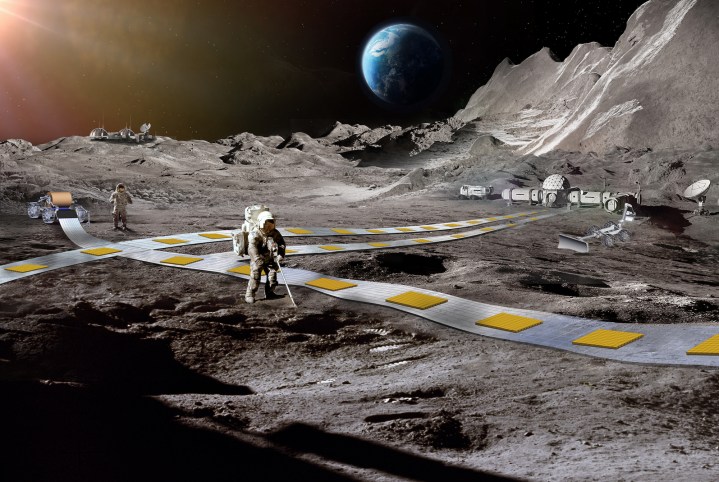
NASA is exploring the idea of building a railway on the lunar surface that uses levitating robots to provide “reliable, autonomous, and efficient payload transport on the moon.”
The space agency said the Flexible Levitation on a Track (FLOAT) system would play a key role in the daily operations of an astronaut-inhabited lunar base, which NASA is hoping to build in the 2030s as part of the Artemis program.
FLOAT would be used to move regolith mined for construction or to transport payloads around the lunar base, as well as to and from landing zones or other locations like exploration sites.
In a post on NASA’s website, Ethan Schaler of the space agency’s Jet Propulsion Laboratory said the FLOAT system would deploy “unpowered magnetic robots that levitate over a 3-layer flexible film track: a graphite layer enables robots to passively float over tracks using diamagnetic levitation, a flex-circuit layer generates electromagnetic thrust to controllably propel robots along tracks, and an optional thin-film solar panel layer generates power for the base when in sunlight.”
Individual FLOAT robots would be capable of transporting payloads of different shapes and sizes at speeds of up to o.5 meters per second, and a large-scale system would be able to move up to 100,000 kilograms of material “multiple kilometers per day.”
Schaler explained that the FLOAT robots would have no moving parts and would levitate over the track to minimize lunar dust abrasion that could cause damage to the system over time. As a result, less maintenance would be required compared to, say, lunar robots with wheels, legs, or tracks.
The tracks for FLOAT would arrive on the moon rolled up before being unfurled directly onto the lunar surface, doing away with the need for challenging and time-consuming construction work by astronauts.
The fascinating idea still has some way to go before it can become a reality. The next step is to build a series of subscale robot and track prototypes for testing in a lunar-analog environment so that the FLOAT design can be refined and improved. Systems for manufacturing the necessary hardware at scale will also have to be developed.
NASA is aiming to send astronauts back to the moon in the Artemis III mission currently set for 2026, and after that, it wants to build a moonbase where astronauts can live and work in a similar way to how they do on the International Space Station today.
Editors’ Recommendations
Services Marketplace – Listings, Bookings & Reviews
